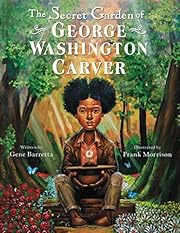

Click on a thumbnail to go to Google Books.
|
Loading... The Secret Garden of George Washington Carver (edition 2020)by Gene Barretta (Author), Frank Morrison (Illustrator)skill in agriculture. The book opens in 1921 as Carver addresses the U.S. Congress, astounding them with dozens of uses for the peanut. The narration then takes readers back to Carver’s childhood to discover how he reached that career highlight. As a child, he loved flowers, but he was warned not to waste time on plants that couldn’t be eaten or sold, so he kept his colorful garden hidden in the woods. Shut out of schools because he was black, he studied nature independently and learned through experimentation. Eventually, he started caring for neighbors’ sick plants, becoming known as “the Plant Doctor.” At 12, he left the farm on which he was raised and attained a formal education, after which he taught students at the Tuskegee Institute and farmers with a mobile classroom mounted on a wagon. This journey through Carver’s childhood and accomplishments ends with Carver’s simple but memorable words, “Regard Nature. Revere Nature. Respect Nature.” The substantial text holds readers on each spread long enough to appreciate not only the subject matter of the painted illustrations, but Morrison’s artistic techniques—strong strokes and careful dots, artful combinations of textures and shapes—which create lush forest scenes and portraitlike human faces and forms. The childhood story feels more cohesive than the final pages, which list his adult accomplishments but lack the narrative thread. Memorable art earns this biography a respectable place on the shelf. (timeline, bibliography, further reading) (Picture book/biography. 4-9) -Kirkus Review This lovely illustrated book is filled with a lot of wonderful text regarding the life of George Washington Carver. Born into slavery in Diamond Grove, Missouri, he was both father and motherless. When he was one year old, the 13th amendment outlawed slavery. Still, that did not grant rights to those of color. Sickly, he spent his time by growing a garden. He developed a deep love and understanding of nature. He attended a colored school. He lived in a series of states, always seeking an education and better understanding of medicinal and beautiful properties of plants. The first black man to obtain a master's degree , he attended Iowa Agricultural College, then moved to the Tuskegee Institute on Alabama and developed and used his love of botany to establish an agricultural program. In 1921, Carver addressed the United State Congress House of Representatives to discuss the benefits of plants, in particular the peanut! This is an incredible story of a man who never gave up his love of learning. George Washington Carver was a plant enthusiast from a very young age, tending to a secret garden located in the woods behind his home. His love of nature would lead him to becoming a successful educator, scientist, and environmentalist, during a time where people like him were not accepted. The story of his life is one I did not know anything about. I thought it was interesting to learn about his roots as a botanist and see how he used his passion to kickstart a successful career helping and educating people about plants and nature. I really enjoyed this book and I think it's very relevant today, given the environmental concerns we are dealing with. I think students would get a new appreciation for nature after reading this and get to learn about an influential African American in a context other than civil rights. |
Current DiscussionsNonePopular covers
 Google Books — Loading... Google Books — Loading...GenresMelvil Decimal System (DDC)630.92Technology Agriculture & related technologies Agriculture Biography; History By Place BiographyLC ClassificationRatingAverage: (4.25) (4.25)
Is this you?Become a LibraryThing Author. |
The book opens in 1921 as Carver addresses the U.S. Congress, astounding them with dozens of uses for the peanut. The narration then takes readers back to Carver’s childhood to discover how he reached that career highlight. As a child, he loved flowers, but he was warned not to waste time on plants that couldn’t be eaten or sold, so he kept his colorful garden hidden in the woods. Shut out of schools because he was black, he studied nature independently and learned through experimentation. Eventually, he started caring for neighbors’ sick plants, becoming known as “the Plant Doctor.” At 12, he left the farm on which he was raised and attained a formal education, after which he taught students at the Tuskegee Institute and farmers with a mobile classroom mounted on a wagon. This journey through Carver’s childhood and accomplishments ends with Carver’s simple but memorable words, “Regard Nature. Revere Nature. Respect Nature.” The substantial text holds readers on each spread long enough to appreciate not only the subject matter of the painted illustrations, but Morrison’s artistic techniques—strong strokes and careful dots, artful combinations of textures and shapes—which create lush forest scenes and portraitlike human faces and forms. The childhood story feels more cohesive than the final pages, which list his adult accomplishments but lack the narrative thread.
Memorable art earns this biography a respectable place on the shelf. (timeline, bibliography, further reading) (Picture book/biography. 4-9)
-Kirkus Review